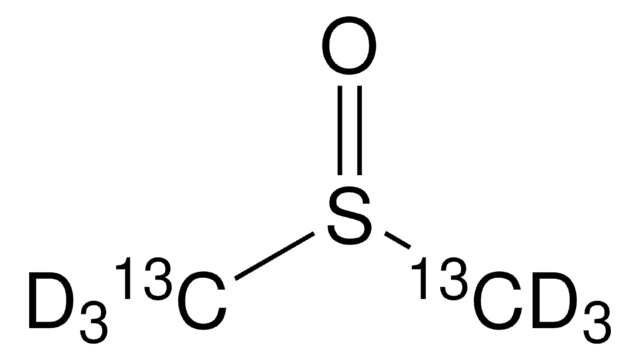The concentration of this product can be determined using the lot-specific purity reported in the Certificate of Analysis, the density, and the compound's molecular weight. This product has a density of 1.190 g/mL and a molecular weight of 84.17 g/mol. The minimum purity is 99.0%, thus the molarity will vary slightly from lot to lot. The molarity can range from 13.9 M (99.0%) to 14.1 M (100%).
156914
Sulfoxyde de diméthyle-d6, Diméthylsulfoxyde-d6
"100%", 99.96 atom % D
Synonyme(s) :
(Sulfoxyde de méthyle)-d6, (Méthylsulfoxyde)-d6, DMSO-d6, Hexadeutérodiméthyl sulfoxyde, Hexadeutérodiméthylsulfoxyde
About This Item
Produits recommandés
Pression de vapeur
0.42 mmHg ( 20 °C)
Niveau de qualité
Pureté isotopique
99.96 atom % D
Essai
≥99% (CP)
Forme
liquid
Température d'inflammation spontanée
573 °F
Limite d'explosivité
42 %
Technique(s)
NMR: suitable
Impuretés
≤0.0250% water
water
Indice de réfraction
n20/D 1.476 (lit.)
pb
189 °C (lit.)
Pf
20.2 °C (lit.)
Densité
1.190 g/mL at 25 °C (lit.)
Changement de masse
M+6
Chaîne SMILES
[2H]C([2H])([2H])S(=O)C([2H])([2H])[2H]
InChI
1S/C2H6OS/c1-4(2)3/h1-2H3/i1D3,2D3
Clé InChI
IAZDPXIOMUYVGZ-WFGJKAKNSA-N
Vous recherchez des produits similaires ? Visite Guide de comparaison des produits
Catégories apparentées
Description générale
Application
Produits recommandés
À utiliser avec
Code de la classe de stockage
10 - Combustible liquids
Classe de danger pour l'eau (WGK)
WGK 1
Point d'éclair (°F)
190.4 °F
Point d'éclair (°C)
88 °C
Faites votre choix parmi les versions les plus récentes :
Déjà en possession de ce produit ?
Retrouvez la documentation relative aux produits que vous avez récemment achetés dans la Bibliothèque de documents.
Les clients ont également consulté
-
Hello, what is the molarity of DMSO-d6 (156914)?
1 answer-
Helpful?
-
-
How can I determine the shelf life / expiration / retest date of this product?
1 answer-
If this product has an expiration or retest date, it will be shown on the Certificate of Analysis (COA, CofA). If there is no retest or expiration date listed on the product's COA, we do not have suitable stability data to determine a shelf life. For these products, the only date on the COA will be the release date; a retest, expiration, or use-by-date will not be displayed.
For all products, we recommend handling per defined conditions as printed in our product literature and website product descriptions. We recommend that products should be routinely inspected by customers to ensure they perform as expected.
For products without retest or expiration dates, our standard warranty of 1 year from the date of shipment is applicable.
For more information, please refer to the Product Dating Information document: https://www.sigmaaldrich.com/deepweb/assets/sigmaaldrich/marketing/global/documents/449/386/product-dating-information-mk.pdfHelpful?
-
-
How is shipping temperature determined? And how is it related to the product storage temperature?
1 answer-
Products may be shipped at a different temperature than the recommended long-term storage temperature. If the product quality is sensitive to short-term exposure to conditions other than the recommended long-term storage, it will be shipped on wet or dry-ice. If the product quality is NOT affected by short-term exposure to conditions other than the recommended long-term storage, it will be shipped at ambient temperature. As shipping routes are configured for minimum transit times, shipping at ambient temperature helps control shipping costs for our customers. For more information, please refer to the Storage and Transport Conditions document: https://www.sigmaaldrich.com/deepweb/assets/sigmaaldrich/marketing/global/documents/316/622/storage-transport-conditions-mk.pdf
Helpful?
-
-
Hello, I am interested in purchasing DMSO-d6 (156914) 10*1 ml. I would like to know how this amount will be packaged (ampoule, vial, bottle)? Thank you!
1 answer-
The packaging for item 156914-10X1ML is a set of 10 - 2mL clear glass flatbottom ampules.
Helpful?
-
Active Filters
Notre équipe de scientifiques dispose d'une expérience dans tous les secteurs de la recherche, notamment en sciences de la vie, science des matériaux, synthèse chimique, chromatographie, analyse et dans de nombreux autres domaines..
Contacter notre Service technique

